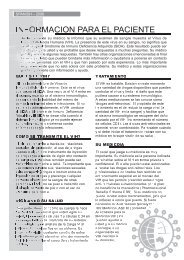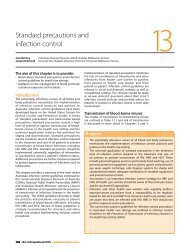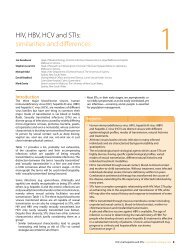B Positive – all you wanted to know about - ASHM
B Positive – all you wanted to know about - ASHM
B Positive – all you wanted to know about - ASHM
You also want an ePaper? Increase the reach of your titles
YUMPU automatically turns print PDFs into web optimized ePapers that Google loves.
6 Clinical assessment of patients with hepatitis B virus infection<br />
a sm<strong>all</strong> proportion of patients (0.1<strong>–</strong>0.5%)<br />
will develop fulminant hepatic failure. this is<br />
believed <strong>to</strong> be due <strong>to</strong> the massive immunemediated<br />
lysis of infected hepa<strong>to</strong>cytes and<br />
therefore, such patients may have no evidence<br />
of active viral replication at the time of<br />
presentation.<br />
the management of acute HbV is symp<strong>to</strong>matic<br />
care. bed rest and nutritional support are<br />
central. anti-nausea medications may be of<br />
benefit and limited doses of paracetamol (< 2g/<br />
day) or codeine may be cautiously administered<br />
for abdominal pain or fevers. since most<br />
patients recover, antiviral therapy is not usu<strong>all</strong>y<br />
recommended. However, case reports and<br />
sm<strong>all</strong> series of patients suggest some benefits<br />
of early therapy. current recommendations<br />
support the use of nucleoside analogues at<br />
the first sign of severe liver injury or impending<br />
hepatic failure. Patients should be moni<strong>to</strong>red<br />
regularly with labora<strong>to</strong>ry tests during the acute<br />
phase of their illness and referred for specialist<br />
review if they have a prolonged prothrombin<br />
time, elevated serum bilirubin concentration,<br />
signs of encephalopathy, or if the illness<br />
is uncharacteristic<strong>all</strong>y lengthy (table 6.2).<br />
continued serological assessment following<br />
recovery from the icteric illness is important <strong>to</strong><br />
identify the sm<strong>all</strong> proportion of patients who<br />
develop cHb.<br />
54 b <strong>Positive</strong> <strong>–</strong> <strong>all</strong> <strong>you</strong> <strong>wanted</strong> <strong>to</strong> <strong>know</strong> <strong>about</strong> hepatitis b: a guide for primary care providers<br />
Managing patients with chronic<br />
HBV infection<br />
chronic HbV can be a life-long disease<br />
and it is important <strong>to</strong> counsel patients as<br />
carefully as possible <strong>about</strong> the disease, the<br />
risks of transmission, and the role of therapy<br />
and its limitations. the epidemiology and<br />
natural his<strong>to</strong>ry of HbV suggest that the<br />
vast majority of patients will come from<br />
cultur<strong>all</strong>y and linguistic<strong>all</strong>y diverse (caLd)<br />
backgrounds. indigenous australians also<br />
have a high prevalence of cHb. a number of<br />
issues inherent in the ethnic diversity arise<br />
when counselling patients <strong>about</strong> cHb. apart<br />
from language difficulties, health practitioners<br />
have <strong>to</strong> be sensitive <strong>to</strong> the cultural beliefs of<br />
specific patient groups and be aware of the<br />
implications of a diagnosis of cHb in various<br />
patient populations. it is often important <strong>to</strong><br />
provide consultation in the presence of other<br />
family members or with an interpreter. HbV<br />
information packages in various languages are<br />
usu<strong>all</strong>y available in major tertiary hospitals.<br />
Various lifestyle issues should be addressed.<br />
alcohol consumption should be ceased or<br />
minimised and cigarette smokers should<br />
quit. Weight reduction with sound nutritional<br />
advice for those with increased body mass<br />
index should be encouraged. issues related<br />
<strong>to</strong> vaccination and transmission have been<br />
previously addressed.<br />
table 6.2: referral guidelines for specialist review of patients with hepatitis b virus infection<br />
Investigations <strong>to</strong> be performed<br />
before referral<br />
Investigations for<br />
hepa<strong>to</strong>cellular carcinoma<br />
surveillance<br />
Criteria for referral of patients<br />
with acute hepatitis B<br />
Criteria for referral of patients<br />
with chronic hepatitis B<br />
Criteria for referral of anti-HBspositive<br />
patients<br />
complete HbV serology (Hbsag, anti-Hbs, anti-Hbc, Hbeag, anti-Hbe)<br />
HbV dna<br />
Liver function tests, full blood count, coagulation profile<br />
Hepatitis c antibody<br />
Hepatitis d antibody<br />
alpha fe<strong>to</strong>protein<br />
abdominal ultrasound<br />
elevated prothrombin time, international normalised ratio or serum bilirubin<br />
concentration<br />
signs of decompensated liver disease (encephalopathy, ascites)<br />
uncharacteristic<strong>all</strong>y lengthy illness<br />
<strong>all</strong> Hbsag-positive patients: particularly if HbV dna > 2000 iu/mL, elevated aLt<br />
levels or features of significant liver damage<br />
if considering immunosuppression (including corticosteroids)<br />
annual moni<strong>to</strong>ring by GP for <strong>all</strong> other anti-Hbs-positive patients (consider inactive<br />
cirrhosis in the older patient)






